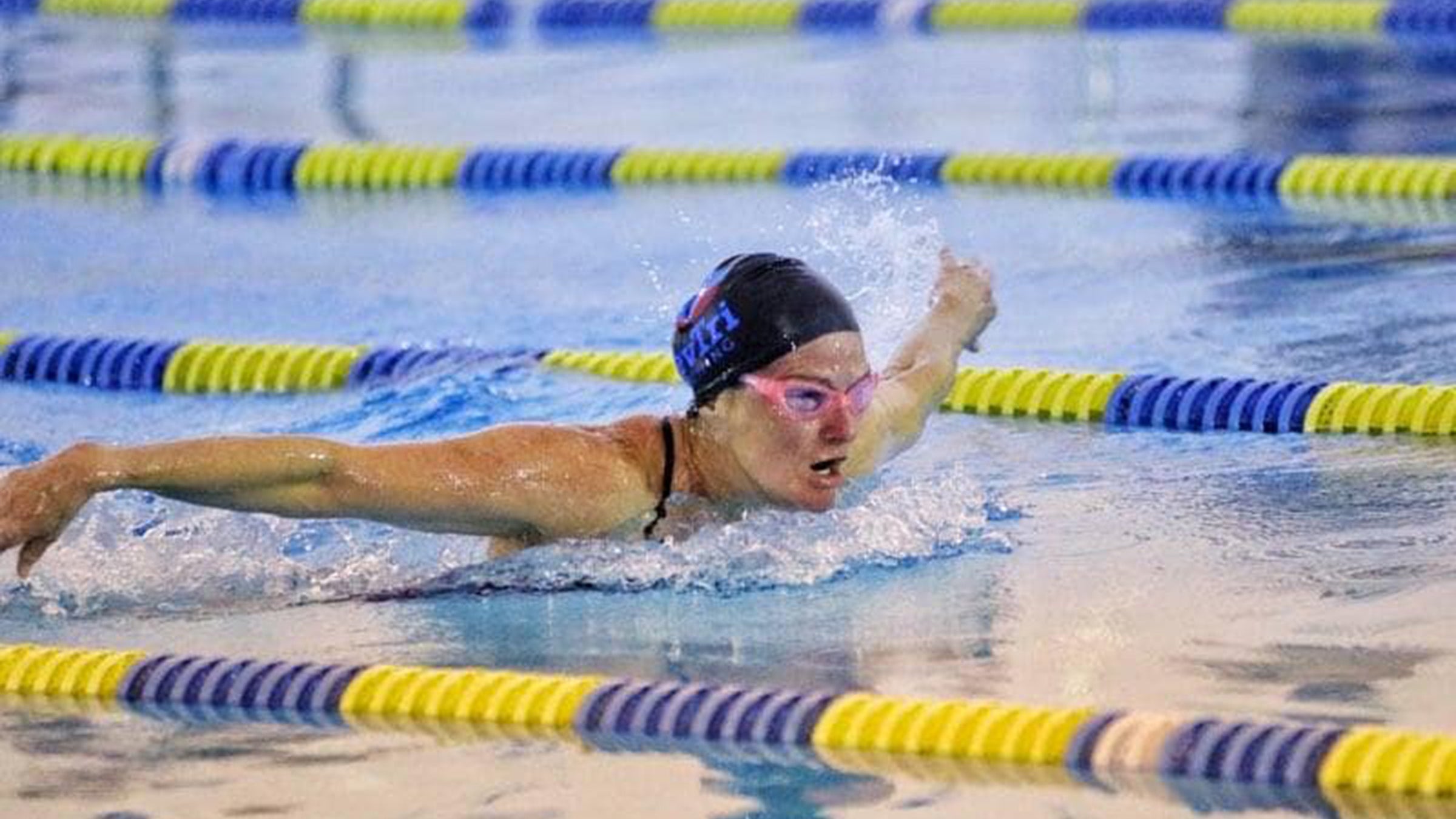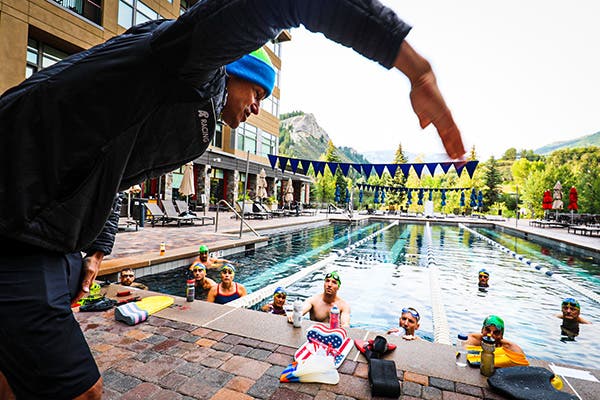Why Triathletes Should Swim Different Strokes

(Photo: Courtesy of Annie Bowman)
Most triathletes swim freestyle—all the time. Every workout, every session in the pool, all freestyle. Many don’t have the expertise, or more often the desire, to try other strokes. Why? Most commonly the answer is: “No point in learning something I’ll never use in a race.” But, what if incorporating breaststroke, butterfly, or backstroke could improve your overall technique, increase endurance, and make you faster?
It’s not crazy.
Why the Experts Recommend Swimming Different Strokes
When you think “first out of the water,” you probably think of one person these days: Lucy Charles-Barclay. That’s because time and time again as this mermaid-like pro continues to set records at races around the world, including breaking the 19-year-old Kona swim course record with a time of 48:13 and taking second at the 1500m at the British Swimming Olympic Trials in a blazing 16:46.26. And that’s right, she swims other strokes in practice.
“There is such a range of benefits to using all strokes in your swim warm-up, main training sets, and cool downs,” Charles-Barclay said. “These benefits range from decreasing muscular tension, built up from only repeating one movement pattern, to improving strength and form in freestyle by understanding the dynamics of other strokes. Variety for the athlete, both mentally and physically, is also important, and I’ve never heard of someone’s form reducing when they practice and understand the other swim strokes. Personally, I feel butterfly is such a great stroke to improve my strength, fitness, and endurance that it always forms a key part of at least one of my sessions a week.”
As a triathlete, so much time is spent in the TT position on the bike that it’s easy for chest muscles to become tight and create tension across the shoulders. Charles-Barclay uses the backstroke to counteract this effect. “I like to incorporate backstroke to balance and reduce the tension created from the amount of front crawl I do,” she said. “Backstroke helps to activate my anterior stabilizers and stretch my pectorals.”
In addition, she says butterfly is a great way to improve body tension and learn how to keep high efficiency through the kinetic chain while swimming.
RELATED: A Complete Guide to Triathlon Swimming
Versatility can also help your development as a swimmer. “I swam a bit of everything, and it definitely helped my development as an athlete,” Andy Potts said—and he should know. During his early career, the six-time All-American swimmer parlayed his success in the pool into an impressive career as a triathlete with an Olympic berth, eight Ironman titles, a 2007 70.3 World Championship win, and national championships in two sports.
Now, as the head of AP Racing, Potts encourages his athletes to become well-rounded swimmers, which means increasing body awareness with drills and a variety of techniques. “I try to touch on all the strokes every practice,” he said. “I think it gives you better water awareness, and that can only help your swimming. I mostly swim freestyle, but your heart and lungs don’t know the difference if you’re challenging them with different strokes.”
Potts explains that backstroke is not only an excellent recovery stroke; it can also provide a dynamic leg workout thanks to a very active kick. Butterfly is great for shoulder mobility and building breath control. Breaststroke can be used to improve timing and challenges your body to move in a non-linear fashion. As triathletes, we generally travel in a single plane of forward motion. Challenging the body to move in a different plane that allows for rotational or side-to-side movement recruits different muscles, which can improve balance, increase strength, and prevent injury.
You can also incorporate other strokes into drills to help with water feel and technique.
“Doing a single arm butterfly with one arm by your side, while kicking with fins, will work your core nicely and is a drill that helps you understand the relationship between your hips and lower body and how that relates to the propulsion forward in freestyle,” said Annie Bowman, a former D1 swimmer at Florida State University, USA Triathlon and Ironman University Coach, and a U.S. Masters swim coach. “The thing about butterfly is that it’s like a type of double armed freestyle. There’s intensity and a lot of energy being produced, so maybe focus on doing three to six strokes off the wall. Just the intensity can provide a lot of benefit as far as exertion. What’s really nice about butterfly is, with the double arm pull, you can feel the catch and power of your stroke.”
Another stroke that has some similarity to freestyle is breaststroke. “It’s similar in the catch portion with the hand pulling through the water with a high elbow, so you’re still getting the benefits of freestyle while doing something different.” That’s another benefit of learning different strokes; it helps break up the monotony of a swim routine. It’s also a good idea to have a bail out stroke for use during a race, just in case you get into trouble.

Using Other Strokes In A Race
We’ve established that incorporating other strokes in the pool has wide-ranging benefits, but you’re never going to use them in a race. Right?
Wrong.
“Sometimes, a triathlete might get overwhelmed when starting an open water swim, so having a different stroke is ideal. For example, with backstroke, you’re breathing fresh air continuously while still making forward progress. With breaststroke, you’re taking gulps of air and you get to keep your head out of the water,” said Bowman.
You can also use another intentionally—as a strategy—at the start or around buoys.
“Depending on the type of swim, I use butterfly when entering and sometimes exiting sea swims as it gives me better reach over waves and means I can make some small gains, which can save energy and get an extra meter or two advantage,” Charles-Barclay said. “This is very dependent on the conditions, as well as the course layout, but it’s a great weapon to have.”
RELATED: How to (Finally) Become A Faster Swimmer
How to Incorporate Other Strokes In Your Workouts
OK, so you’re convinced, but how do you go about adding other strokes into your workouts?
One method of incorporating butterfly or backstroke is by using it during the recovery portion of a hard freestyle set. “I would do 75m hard freestyle, but use backstroke for my recovery 25m,” said Charles-Barclay. “This helps regulate my breathing and loosen the front of my shoulders, but it also works the full shoulder muscle group and gives me some mental variation. This can also be done with 75m easy freestyle and then 25m hard butterfly in a similar way.”
Another easy way to add a new stroke in is during a kick set. If you’re kicking with fins, use a breaststroke pull to come up for a breath. “Also, the dolphin kick that’s used in butterfly helps to activate your quads on the way down and your hamstrings on the way up, as well as your core to help everything remain stable,” said Bowman.
Of course, you can also use the other strokes as a way to simulate the fatigue from racing, and building the endurance and strength you need for triathlon. Potts likes to add an individual medley (butterfly, backstroke, breaststroke, and freestyle) in his warm-up before a main set. “I like ending the warm-up with IMs, so my body is ready for anything,” he said.
Another option: “A great pre-main set is to do some 100s with the first 25m as butterfly, so you get fatigued early on and have to teach your body how to adapt. A lot of triathletes like to take the first 100-200 meters out fast in a race, but they don’t prepare for it. You need to front load some fatigue and speed, if that’s your strategy. If you don’t prepare to take it out hard, you will fade fast after the first buoy.”
Remember, though, that swimming is 90% technique, so if you don’t know how to do other strokes, commit some time to learning the fundamentals before diving into the deep end.
Try this workout from Andy Potts
Warm up:
600 (3 x 150 free/50 back)
4 x 100 IM continuous (no rest)
Pre set:
8 x 100, descend 1-4, 5-8 (first 25 fly, in each 100)
Main set:
4 x 600, descend 1-4
Post set:
1000 as 500 pull/5 x 100 IM with fins (continuous)